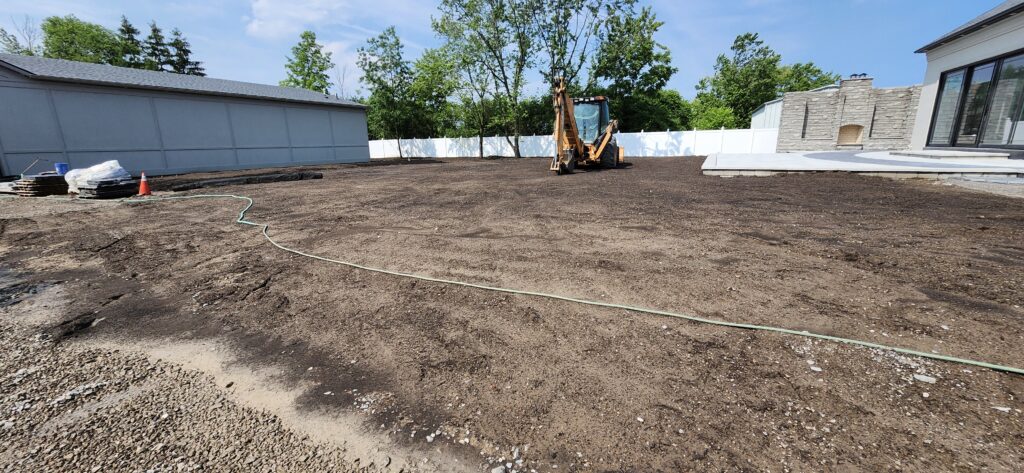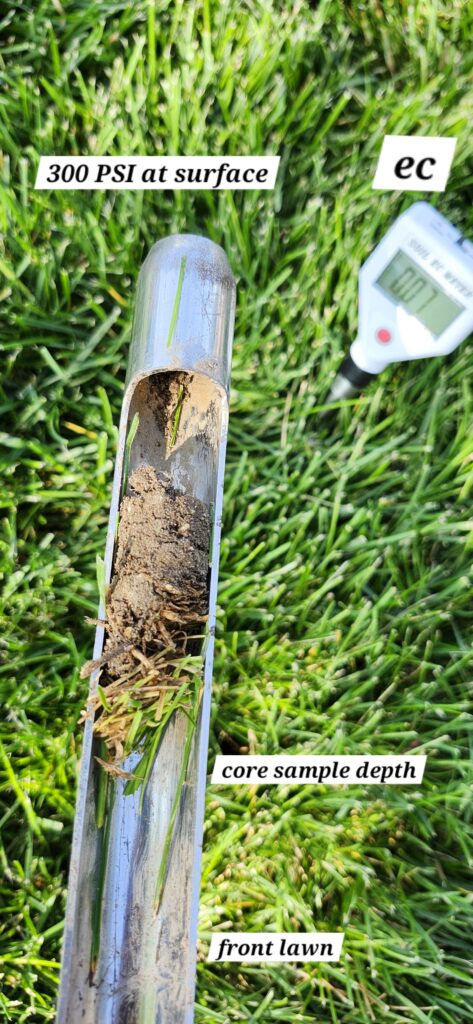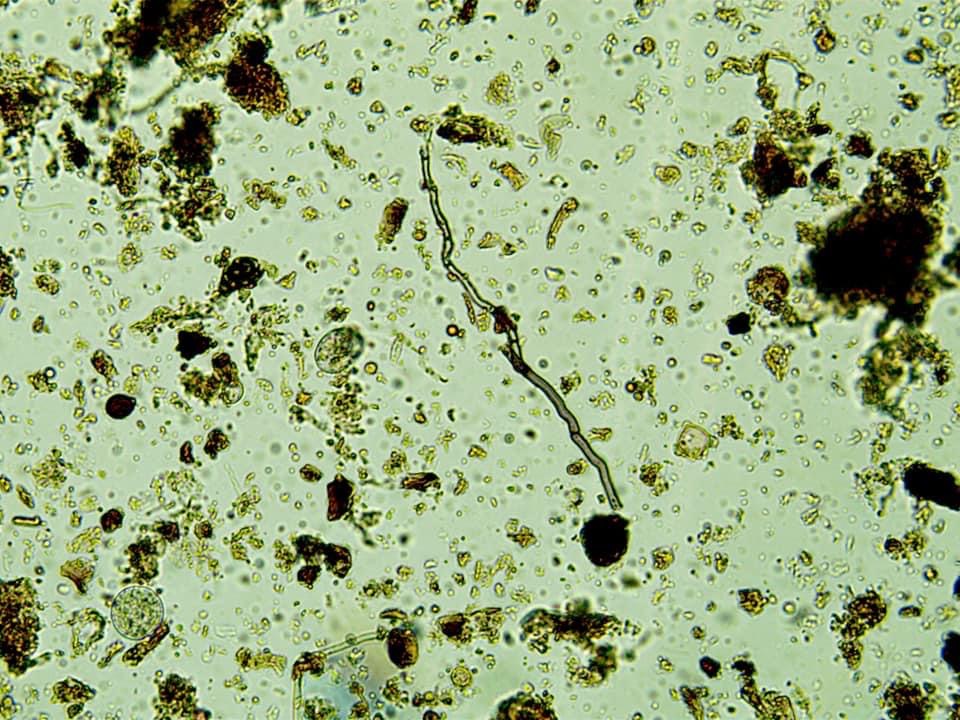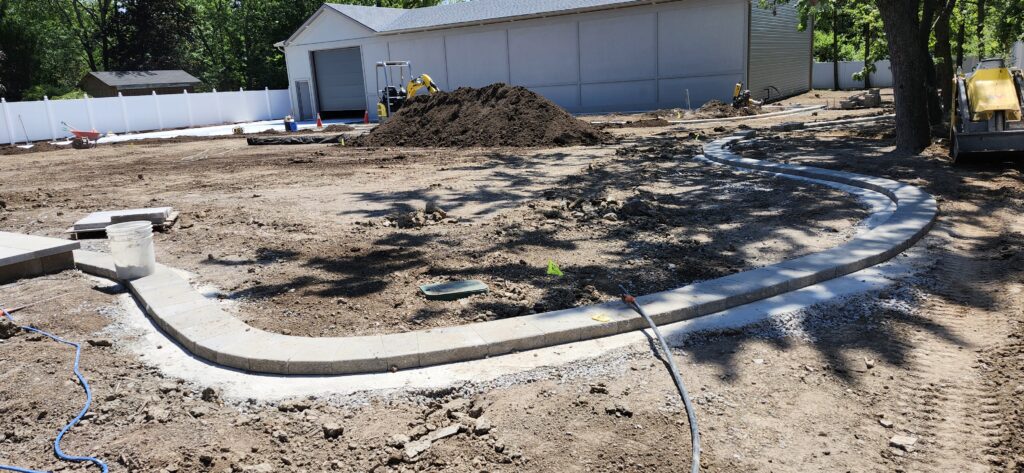Landscaping and lawn care are often perceived as straightforward tasks. Many professionals and DIY enthusiasts follow traditional practices such as heavy machinery use, grading, and applying a layer of topsoil before planting or laying sod. However, these methods can lead to significant soil compaction and long-term soil health issues, masked temporarily by nature’s interventions, like rain. When summer heat and drought come, these hidden problems emerge, revealing the inadequacies of conventional practices. This comprehensive guide explores the hidden dangers of soil compaction and offers sustainable solutions to create healthier landscapes.

Understanding Soil Compaction
Soil Compaction: Soil compaction occurs when soil particles are pressed together, reducing pore space between them. This process can result from various factors, including the use of heavy machinery, foot traffic, and the natural settling of soil.
Optimal Soil Compaction: Ideal soil compaction should be between 150 to 200 PSI. However, many landscapes show compaction levels exceeding 300 PSI, especially at the surface, significantly restricting air, water, and root penetration.

Key Impacts of Soil Compaction:
- Reduced Water Infiltration and Retention: Compacted soil inhibits water infiltration, leading to increased runoff and erosion. This reduces the amount of water available to plants and contributes to water wastage.
- Poor Root Development: Limited pore space restricts root growth, leading to shallow root systems that are less able to access nutrients and water.
- Decreased Soil Aeration: Compacted soil lacks the necessary air spaces that allow oxygen to reach plant roots and soil microorganisms, essential for healthy soil biology.
- Increased Susceptibility to Pests and Diseases: Stressed plants in compacted soils are more vulnerable to pests and diseases, as their natural defense mechanisms are weakened.

The Role of Soil Biology
Soil Biology: Healthy soil is teeming with life, including bacteria, fungi, protozoa, and other microorganisms. These organisms play critical roles in nutrient cycling, soil structure formation, and plant health.
Rhizophagy Cycle: The rhizophagy cycle is a process where plants absorb microbes from the soil into their roots. These microbes are partially digested, releasing nutrients directly to the plant. Excessive use of chemical fertilizers and pesticides disrupts this natural process, killing beneficial soil microbes and hindering nutrient cycling.
Importance of Soil Life:

- Nutrient Cycling: Soil organisms decompose organic matter, fix nitrogen, and make nutrients available to plants.
- Soil Structure: Microorganisms help create soil aggregates that improve soil structure, porosity, and water retention.
- Plant Health: A diverse soil microbiome enhances plant resilience against pests, diseases, and environmental stresses.
Compaction and Anaerobic Conditions
Anaerobic Conditions: Compaction causes poor soil aeration, leading to anaerobic conditions where oxygen is limited. These conditions are detrimental to soil biology and plant health, resulting in several negative impacts:
- Formation of Hardpans: Compacted layers, or hardpans, trap water and minerals (salts) above them. During summer, water evaporates and salts wick upwards through the soil, causing surface salinization. This process harms plants, turning them brown and unhealthy.
- Biological Elixir: The trapped water and salts above the hardpan create an anaerobic “elixir” that fosters the production of harmful substances such as acids, vinegar, and formaldehyde. These conditions restrict root growth, cause root dieback, promote disease, and attract insect pests.
The Role of Carbon in Soil Health

Carbon Oxidation: During landscaping activities, open soil is exposed, creating conditions conducive to carbon oxidation. This process depletes soil organic matter, critical for maintaining soil structure, fertility, and microbial activity.
Impact of Nitrogen Fertilization: While nitrogen fertilizers are often applied to promote fast grass growth, they can reduce soil carbon content. High nitrogen levels stimulate microbial activity that decomposes organic matter faster than it can be replenished, leading to long-term soil degradation and increased soil salinity.
Consequences of Conventional Practices: Many landscaping and lawn care companies apply fertilizers and other chemical inputs without understanding their long-term effects. The pursuit of a visually perfect lawn often leads to practices that exacerbate soil compaction and degrade soil health. These companies tend to blame issues on inadequate watering, not recognizing the underlying problems caused by their own methods.
How Nature Hides Our Inadequacies
Nature’s Role: Nature often masks the impacts of poor landscaping practices through rain and seasonal cycles. Rain can temporarily alleviate compaction by softening the soil surface and promoting superficial root growth. However, these effects are short-lived, and underlying issues resurface during droughts and heatwaves.
Legacy Issues: Many properties have legacy soil issues stemming from historical land use, such as farming or construction. These issues include heavy clay soils, poor soil structure, and contamination with construction debris and chemicals.
Example: A common scenario involves a landscape project where heavy machinery compacts the soil, topsoil is added, and plants or sod are installed. Initially, the landscape may appear healthy, but underlying compaction issues become evident during stressful conditions like summer heat, resulting in poor plant health and water management problems.
Sustainable Solutions
1. Soil Aeration:
- Regular aeration helps alleviate compaction and improve air and water penetration. Focus on areas with high compaction to reduce levels to the optimal range of 150-200 PSI.
- Combining aeration with organic amendments like our Pelletized Ultimate Compost and Nature’s Brew enhances soil health.
2. Soil Amendments:
- Calcium Application: Incorporating calcium within our Nature’s Brew relaxes soil compaction and improves soil structure.
- Organic Matter Addition: Adding organic matter boosts soil fertility and moisture retention.
- Microbial Extracts: Using Nature’s Brew extracts increases microbial activity, rejuvenating soil health.
3. Water Management:
- Proper irrigation practices avoid water runoff and promote even water distribution. Monitor and adjust irrigation based on soil moisture levels and plant needs, following the Goldilocks Principle (not too much, not too little, but just right).
4. Long-term Soil Health:
- Reduce the use of chemical fertilizers and sprays that deplete soil life and carbon content.
- Promote organic and regenerative practices to build sustainable soil health.
- Encourage proper mowing practices to avoid scalping and maintain optimal turf performance.
The Role of Canadian Thistle

Canadian Thistle: Canadian thistle is a plant known for its deep taproot, capable of breaking up soil compaction at depths where compaction can exceed 600 PSI. This plant can be seen as nature’s way of addressing severe soil compaction, indicating areas with poor soil structure, lack of air, and deficiencies in calcium and phosphorus.
Conclusion
Compaction is a silent killer in landscaping, often exacerbated by conventional practices. Recognizing the signs and understanding the impacts of soil compaction is crucial for creating sustainable and healthy landscapes. At Stangl’s Enviro Lawn Care, we prioritize soil health through sustainable practices, focusing on microbial activity, soil structure, and proper irrigation. By addressing the underlying soil issues and implementing our recommended practices, we can achieve long-term success and create a healthy, vibrant environment for your plants.
Contact Information:
Stangl’s Enviro Lawn Care
info@stangls.com
This guide emphasizes the importance of soil health and offers practical solutions to overcome compaction and other soil-related challenges. By adopting these practices, we can enhance landscape sustainability and resilience.